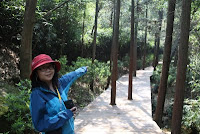
Historic Tai Mu Mountain mentioned in the Classic of Tea by Lu Yu as a famed tea growing area for white tea preferred by the Song emperor over one thousand years ago. On the northern Fujian coast, this rocky high point is the legendary birth-place of white tea. Here there are towers of bare rock face, sometimes guazed in cool mist. Much of the time covered in clouds, opaque at night, and during the day blinding white, it is a national park.
As one approaches, Tai Mu Shan looks on the outside like any of many less than fascinating tourist destinations in China, but once through gauntlet of stores selling items beneath the dignity of people, including even green tea dissembling as white, a wonderful park opens out.
Rising above are wide gray swaths of soft, undulating granite. Shocks of the hardest stone left by whatever geologic firestorm squeezed the light colored molten rock to the surface. There are bubbles and holes with rich orange earth beneath we we gently ascend through a green wooded canyon, gradually closing in.

Holes are cut in the board-walk for the spindly trees, and various walks snake off. A detailed map could rate them by their difficulty. One is a new, almost entirely flat grade suspended on the sheer southern face, a stunning and peaceful way to descend from the top to the famous cave that gives this park its fame. Other paths ascend on roughly hewn stairs, and one approach even snakes under the cool and damp, massive tumbles of granite, foliage and moss, crossing an underground reservoir on stepping stones, where I had to take off my backpack to pass.

When we finally reach the cave entrance, there is only a single long and narrow tea tree growing behind a fence. There are shrines, and some monks tell us the tea trees have been cut down. He waves to a far hillside perhaps a kilometer distant where tea is terraced, and says, on a good day we can see the sea from here. I ask if he has some place he can go where the tourists don’t come. He says he does. Inside the Buddhist temple there is a vegetarian restaurant, and after two volunteers there ask to take a photo with us, we decide to eat with them. In minutes two bowls of two different soups, which should be called stews for all the various vegetables and shoots and mushrooms in them. The soup was so good we wrote a note praising it and encouraged them to begin placing such notes on their wall.
(video: walking up, cave, tea plant, inside cave - mar talking, monk, into temple, eating, pull back from monestary)
